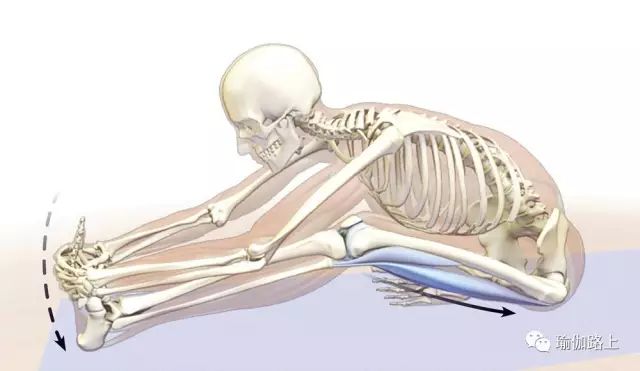Add the teacher’s wechat circle of friends around the teacher ~ in yoga class, students should have heard a lot of “contradictory” commands, such as “find the feeling of bending back in forward bending”, “find the feeling of foot grounding in head handstand” and “take root down to better up”.

For example, today we want to say “stretch the back of the thigh and bend the leg first”.

The tension at the back of the thigh will lead to excessive bending (extrusion) of the middle lumbar spine in forward bending.
Stretching the back of the thigh can improve this problem.
Today, let’s talk about a simple but useful technique – using the “spinal reflex arc” to create the extension of the back of the thigh.
What is spinal reflex arc? The spinal reflex arc consists of sensory nerve receptors on or near the muscle.
Its connection returns to the muscle through a nerve in the spine – an intermediate neuron in the spinal cord – and an afferent nerve.
We can use the Golgi tendon organ in this reflex arc to lengthen the muscle.
This sensor is located at the muscle tendon junction and senses changes in muscle tension.
When the tension increases, the Golgi tendon organ sends a signal to the spinal cord.
The spinal cord tells the muscles to relax.
In essence, this reflex arc releases a “Relaxation” signal to relieve the tension of the muscle tendon knot and help prevent tendon strain.
What is neuromuscular proprioception? Long ago, sports medicine experts believed that as long as you are careful, you can use this special reflection arc to lengthen muscles.
Using this knowledge, they invented a technique called neuromuscular proprioception, or muscle stretching.
This is the most effective way to promote muscle lengthening and improve flexibility.
There is stretching in yoga, so why not apply this technique to asana practice to make asana more in-depth? It is important to remember that any powerful tool, including yoga asana itself, is a double-edged sword.
If you use it carelessly, it will cause harm.
The same goes for this technique to promote muscle stretching.
The key to using this technique is to be careful and slow.
When stretching, use a small amount of muscle strength, not too much.
The techniques to promote muscle stretching are as follows: after warming up, we begin to gently stretch the target muscle.
At this point, the muscle will enter a “set length” – the longest stretch that the brain thinks the muscle will stretch.
Stretching that muscle will make the muscle tendon knot tense and activate the Golgi tendon organ there.
After a few tendons are “stretched”, the key is to let the muscles in the spinal cord contract more strongly, so that we can stop the muscle contraction at the same time.
The end result is that the muscle stretches more and the brain “sets the length” of the muscle again.
How to use the skill of promoting muscle stretching in one leg head to knee contact? We demonstrate this technique in detail by touching the head of one leg with the knee, which is used to stretch the muscles behind the thigh.
First, warm up with several times of sun worship AB, and then do one leg head to knee.
Fold the body over the straight leg and activate the quadriceps femoris (the muscle in the front of the thigh) to adapt to the stretching of the back of the thigh.
Then bend your knees about 20 °.
Although this will reduce the stretching of the back of the thigh and thus reduce the tension of the muscle tendon knot, bending the knee can give us more power in the stage of contraction in promoting muscle stretching.
Then, press the heel of the straight leg down on the cushion (as if you were trying to bend your knee), which will shrink the back of the thigh and slowly increase the strength to establish this tension.
Then stop when your strength increases to 20%, maintain this strength, keep the thigh muscles activated for more than 5 breaths, and then slowly reduce the strength and release the contraction in 1-2 seconds.
This will enhance the “relax” command from the spinal cord.
Now, slowly straighten the knee, activate the quadriceps femoris and slowly go deep into the pose.
Starting the quadriceps not only straightens the knee, but also makes better use of the “Relaxation” effect to stretch the back of the thigh.
Repeat with another leg.
Relax for a while, then stand and bend forward to feel the change.
Remember to be careful when using techniques that promote muscle stretching.
At least 48 hours between using this technique on the same muscle twice to give it time to repair and consolidate.
spot.


